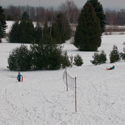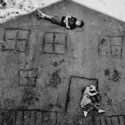 This past winter, the snow stayed so long we almost forgot what the ground looked like. In Detroit, there is little money for plowing; after a big storm, the streets and sidewalks disappear for days. Soon new pathways emerge, side streets get dug out one car-width wide. Bootprints through parks veer far from the buried sidewalks. Without the city to tell him where to walk, the pilgrim who first sets out in fresh snowfall creates his own path. Others will likely follow, or forge their own paths as needed.
This past winter, the snow stayed so long we almost forgot what the ground looked like. In Detroit, there is little money for plowing; after a big storm, the streets and sidewalks disappear for days. Soon new pathways emerge, side streets get dug out one car-width wide. Bootprints through parks veer far from the buried sidewalks. Without the city to tell him where to walk, the pilgrim who first sets out in fresh snowfall creates his own path. Others will likely follow, or forge their own paths as needed.
In the heart of summer, too, it becomes clear that the grid laid down by the ancient planners is now irrelevant. In vacant lots between neighborhoods and the attractions of thoroughfares, bus stops and liquor stores, well-worn paths stretch across hundreds of vacant lots. Gaston Bachelard called these les chemins du désir: pathways of desire. Paths that weren't designed but eroded casually away by individuals finding the shortest distance between where they are coming from and where they intend to go.
It is an urban legend on many college campuses that many sidewalks and pathways were not planned at all, but paved by the university after students created their own paths from building to building, straying from those originally prescribed. The Motor City, like a college campus, has a large population that cannot afford cars, relying instead on bikes and feet to meet its needs. With enormous swaths of the city returning to prairie, where sidewalks are irrelevant and sometimes even dangerous, desire lines have become an integral yet entirely unintended part of the city's infrastructure. There are hundreds of these prescriptive easements across neglected lots throughout the city. Click on the photo at the top of this post to see just a few of them in greater detail. Desire lines are considered by many landscape architects to be proof of a flaw in the design of a physical space, or more gently, a sign that concrete cannot always impose its will on the human mind. But what about a physical space that no longer resembles its intended design, a city where tens of thousands of homes have been abandoned, burned, and buried in their own basements? While actual roads and sidewalks crumble with each season of freezing and thawing, Detroiters have taken it upon themselves to create new paths, in their own small way working to create a city that better suits their needs.
Desire lines are considered by many landscape architects to be proof of a flaw in the design of a physical space, or more gently, a sign that concrete cannot always impose its will on the human mind. But what about a physical space that no longer resembles its intended design, a city where tens of thousands of homes have been abandoned, burned, and buried in their own basements? While actual roads and sidewalks crumble with each season of freezing and thawing, Detroiters have taken it upon themselves to create new paths, in their own small way working to create a city that better suits their needs.
 Academics around the world argue about whether the first paths were created by hunters following game trails. There are scientists who study ants to better understand highways. They have created mathematical models for trail formation. When the great cities were built, sometimes roads were built along ancient paths. The Romans imposed grids on every city but their own. In Detroit many of the streets are named for the Frenchmen whose ribbon farms stretching north from the river were covered in asphalt: Beaubien, Dequindre, Campau, Livernois, Chene. In many cities, there are streets named for dead men once revered throughout the land but now mostly forgotten (Fulton, Lafayette, Irving) and others named for men no one remembers.
Academics around the world argue about whether the first paths were created by hunters following game trails. There are scientists who study ants to better understand highways. They have created mathematical models for trail formation. When the great cities were built, sometimes roads were built along ancient paths. The Romans imposed grids on every city but their own. In Detroit many of the streets are named for the Frenchmen whose ribbon farms stretching north from the river were covered in asphalt: Beaubien, Dequindre, Campau, Livernois, Chene. In many cities, there are streets named for dead men once revered throughout the land but now mostly forgotten (Fulton, Lafayette, Irving) and others named for men no one remembers.
In Detroit, there are streets no one has named. And they belong to anyone.
Copyright © 2005-2016 Sweet Juniper Media, Inc.
All Rights Reserved.
All Rights Reserved.
"Sweet Juniper" is a registered trademark.
No unauthorized reuse.
No unauthorized reuse.
Categories
- Friday Morning Street Urchin Blogging ( 107 )
- Detroit ( 60 )
- SAHD ( 34 )
- photography ( 30 )
- Thursday Morning Wood ( 25 )
- Halloween ( 23 )
- Thrift ( 18 )
- abandoned places ( 18 )
- terrifying nixon-era children's books ( 16 )
- Reminiscin' ( 15 )
- Sweet Juniper Media ( 11 )
- Wendell ( 10 )
- Design ( 9 )
- San Francisco ( 9 )
- nature fights back ( 9 )
- sleep ( 9 )
- if you ain't dutch you ain't much ( 8 )
- sentimental ( 7 )
- Music ( 6 )
- Parody ( 6 )
- birth story ( 6 )
- scrappers ( 6 )
- Sweet Juniper Tunes ( 5 )
- lawyering ( 5 )
- Zoo ( 4 )
- elegant leisure ( 4 )
- language ( 3 )
- feral houses ( 2 )
- theme parks of the damned ( 2 )
- zombies ( 1 )
Archives
- November 2017 ( 2 )
- December 2016 ( 1 )
- November 2016 ( 2 )
- December 2015 ( 1 )
- November 2015 ( 2 )
- December 2014 ( 1 )
- October 2014 ( 2 )
- April 2014 ( 1 )
- December 2013 ( 2 )
- November 2013 ( 1 )
- October 2013 ( 1 )
- September 2013 ( 2 )
- July 2013 ( 2 )
- June 2013 ( 1 )
- April 2013 ( 1 )
- March 2013 ( 3 )
- February 2013 ( 1 )
- January 2013 ( 1 )
- December 2012 ( 2 )
- November 2012 ( 1 )
- October 2012 ( 4 )
- September 2012 ( 2 )
- August 2012 ( 2 )
- July 2012 ( 1 )
- June 2012 ( 3 )
- May 2012 ( 1 )
- April 2012 ( 2 )
- March 2012 ( 1 )
- February 2012 ( 2 )
- January 2012 ( 1 )
- December 2011 ( 3 )
- November 2011 ( 3 )
- October 2011 ( 5 )
- September 2011 ( 3 )
- August 2011 ( 4 )
- July 2011 ( 4 )
- June 2011 ( 2 )
- May 2011 ( 4 )
- April 2011 ( 6 )
- March 2011 ( 7 )
- February 2011 ( 4 )
- January 2011 ( 4 )
- December 2010 ( 5 )
- November 2010 ( 7 )
- October 2010 ( 5 )
- September 2010 ( 4 )
- August 2010 ( 5 )
- July 2010 ( 7 )
- June 2010 ( 5 )
- May 2010 ( 5 )
- April 2010 ( 5 )
- March 2010 ( 4 )
- February 2010 ( 5 )
- January 2010 ( 5 )
- December 2009 ( 6 )
- November 2009 ( 5 )
- October 2009 ( 8 )
- September 2009 ( 9 )
- August 2009 ( 6 )
- July 2009 ( 9 )
- June 2009 ( 8 )
- May 2009 ( 8 )
- April 2009 ( 8 )
- March 2009 ( 12 )
- February 2009 ( 11 )
- January 2009 ( 9 )
- December 2008 ( 11 )
- November 2008 ( 9 )
- October 2008 ( 14 )
- September 2008 ( 11 )
- August 2008 ( 11 )
- July 2008 ( 12 )
- June 2008 ( 10 )
- May 2008 ( 9 )
- April 2008 ( 8 )
- March 2008 ( 10 )
- February 2008 ( 15 )
- January 2008 ( 12 )
- December 2007 ( 9 )
- November 2007 ( 12 )
- October 2007 ( 11 )
- September 2007 ( 13 )
- August 2007 ( 11 )
- July 2007 ( 8 )
- June 2007 ( 12 )
- May 2007 ( 10 )
- April 2007 ( 10 )
- March 2007 ( 12 )
- February 2007 ( 14 )
- January 2007 ( 12 )
- December 2006 ( 11 )
- November 2006 ( 10 )
- October 2006 ( 13 )
- September 2006 ( 8 )
- August 2006 ( 13 )
- July 2006 ( 13 )
- June 2006 ( 15 )
- May 2006 ( 13 )
- April 2006 ( 9 )
- March 2006 ( 10 )
- February 2006 ( 3 )
- January 2006 ( 5 )
- December 2005 ( 2 )
- November 2005 ( 8 )
- October 2005 ( 4 )
- September 2005 ( 1 )
- July 2005 ( 3 )


























